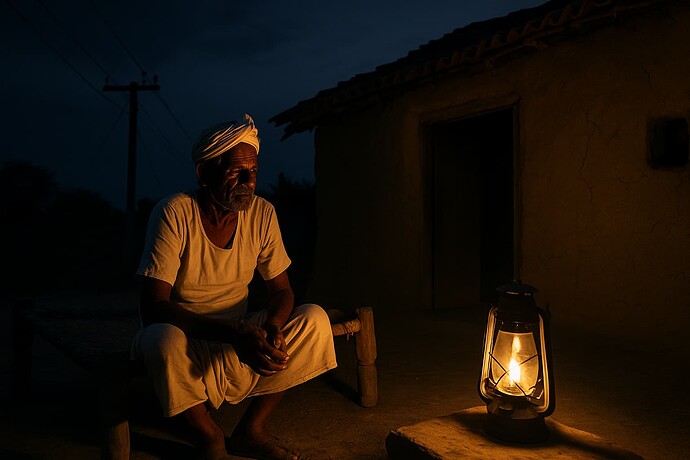Introduction Electricity is a critical enabler of development, yet millions of India’s rural farming households still experience erratic or limited power supply. While official records claim near-universal electrification, the ground reality in many villages across states like Uttar Pradesh, Bihar, Jharkhand, Madhya Pradesh, Odisha, and parts of Rajasthan is starkly different. For farmers, unreliable electricity impacts irrigation, productivity, home life, and education. This report outlines the current status, challenges, and implications of electricity shortages for India’s farming families, based on field observations and data available as of 26 April 2025.
1. Status of Rural Electrification
- As per Saubhagya Yojana data (2023), 100% villages are electrified – meaning electricity lines reach village transformers.
- However, only about 76% of rural households report having reliable electricity, with many facing frequent outages or voltage issues.
- In states like Bihar and Uttar Pradesh, farmers report power cuts lasting 8–14 hours daily, especially during summer and sowing seasons.
2. Impact on Agricultural Productivity
- Electric pump irrigation becomes unreliable due to erratic supply; many farmers switch to costlier diesel pumps.
- Timely irrigation of crops like wheat, paddy, or sugarcane gets delayed, lowering yields.
- Crop spoilage is common due to non-functional cold storage and grain dryers.
3. Household Inconvenience and Educational Disruption
- Children in farmer households struggle to study at night due to no light.
- Women face difficulties managing household chores without electricity.
- Lack of power affects mobile charging and access to digital services like telemedicine or agri-advisory apps.
4. Financial Strain and Dependence on Alternatives
- Diesel pump use raises irrigation costs by ₹1,500–₹3,000 per acre per season, affecting marginal farmers.
- Private microgrids or solar home kits are unaffordable or limited in usage.
- Farmers often pay bribes to get new connections or upgrades due to local corruption.
5. Regional Disparities and Data Gaps
- Southern states (Tamil Nadu, Kerala, Andhra Pradesh) and Himachal Pradesh offer near 24/7 supply to rural homes.
- Eastern India (especially Bihar, Jharkhand) and Bundelkhand region of UP remain worst affected.
- Even within a district, large farmers get better electricity access than marginal or SC/ST households.
6. Government Schemes and Their Implementation
- Deen Dayal Upadhyaya Gram Jyoti Yojana (DDUGJY) aimed to separate agricultural feeders, but implementation is partial.
- KUSUM scheme promotes solar-powered pumps, but its rural reach remains below target.
- State DISCOMs are financially stressed and fail to maintain rural feeder lines.
7. Farmer Voices and Ground Realities
- “We get light for 4 hours at night, never during the day when we need it for farming,” says a farmer in Bhojpur, Bihar.
- “Even when we get power, voltage is too low to run our pumps,” reports a cultivator in Banda, Uttar Pradesh.
- “Solar would help but the subsidy process is too slow and complicated,” says a farmer from Barwani, Madhya Pradesh.
Conclusion Electricity in rural India is not just a development metric—it is a lifeline for farmers. Inconsistent and poor-quality supply undermines productivity, education, health, and dignity. Without targeted upgrades to feeder lines, DISCOM support, and access to off-grid renewables, the rural electricity divide will continue to hold back India’s farmers.
Recommendations
- Prioritize rural feeder upgrades and maintenance under a National 24x7 Rural Power Plan.
- Scale up KUSUM implementation with simplified subsidy access for solar pumps.
- Expand decentralized solar microgrids for remote hamlets.
- Digitize real-time rural outage monitoring with farmer SMS/IVR reporting.
- Offer free or low-interest loans for energy-efficient appliances and home electrification.
- Integrate electricity access metrics into rural poverty and agri-risk assessments.
Prepared by: Famalth Research Desk (26 April 2025)
